
Order Blattodea (Cockroaches and Termites) in the Christopher B. Smith Preserve
Order Blattodea Characteristics: All members of Order Blattodea have incomplete metamorphosis (egg, nymph, and adult stages). They also have chewing mouthparts.
A 2007 genetic research study confirmed that termites are really cockroaches. The paper is titled "Death of an order: a comprehensive molecular phylogenetic study confirms that termites are eusocial cockroaches." Eusocial is the highest level of social organization. This organization (colony) has: 1) cooperative brood care, 2) overlapping adult generations, and 3) division of labor by both non-reproductive and reproductive individuals. Before this genetic study was performed, termites were classified in their own order, "Isoptera." Now, they are considered members of Family Termitidae in Order Blattodea. Below are characteristics of non-termite cockroaches and termite cockroaches.
A) Non-Termite Cockroaches: At least 38 species of non-termite cockroaches live in Florida. Most live outdoors. When viewed from above, a cockroach's head is concealed by its pronotum (the foremost segment of the thorax). Most species have wings held flat over the back. The front wings are leathery, antennae are long, and legs are usually very spiny. Adults have large, segmented cerci (paired appendages on the tip of the abdomen). Most non-termite cockroaches are omnivorous. Some wood-eating species are able to eat cellulose because of symbiotic protozoans and bacteria that live inside their digestive systems.
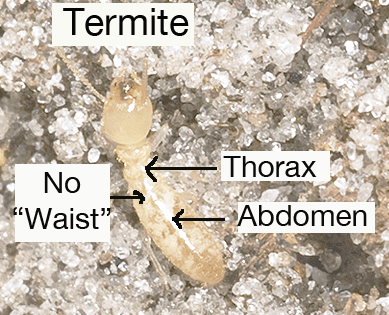
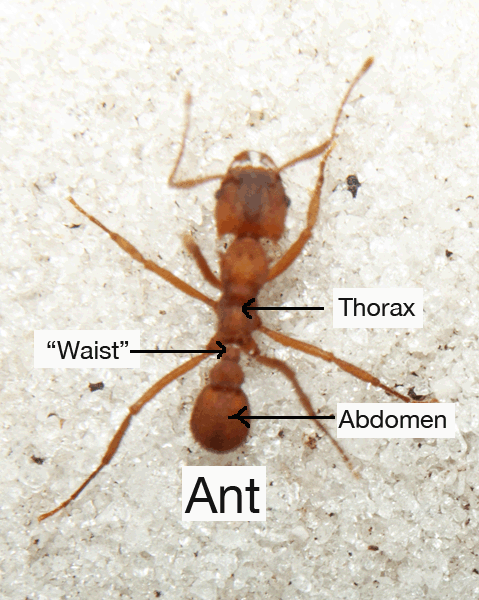 B) Termite Cockroaches: There are only 17 species of termites living in Florida. Termites are often confused with ants, but there are several distinctive differences. As shown in these photographs, ants have a narrow division ("waist") between the thorax and abdomen; termites lack this "waist." Winged ants have long, narrow, triangular front wings and much larger hind wings. Winged termites have two pair of wings that are paddle-shaped and almost identical in size. Ants are often seen crawling during the day; termites are rarely seen because they do not venture outside the colony except to reproduce. Termites, like ants, are social insects, but unlike ants, both males and females can be workers or soldiers.
B) Termite Cockroaches: There are only 17 species of termites living in Florida. Termites are often confused with ants, but there are several distinctive differences. As shown in these photographs, ants have a narrow division ("waist") between the thorax and abdomen; termites lack this "waist." Winged ants have long, narrow, triangular front wings and much larger hind wings. Winged termites have two pair of wings that are paddle-shaped and almost identical in size. Ants are often seen crawling during the day; termites are rarely seen because they do not venture outside the colony except to reproduce. Termites, like ants, are social insects, but unlike ants, both males and females can be workers or soldiers.
Much of the work in the termite colony is done by young termites. Worker termites eat cellulose in dead twigs, fallen branches, pinecones, dead leaves, and other plant debris, and excrete sugar. They feed the sugar to other members of the colony. A termite's ability to eat cellulose is made possible because cellulose is decomposed by many species of microorganisms living inside its intestinal tract. As sugar is fed to other colony members, gut symbionts are transferred from one generation to another. Florida worker termites are pale and grub-like, as shown in the photograph above. Workers can transform into queens if a queen dies or if the colony becomes very large. Workers can also develop into winged queens and males that disperse, or into soldiers. A worker's development depends on the balance of hormones circulating within the colony. Most species have blind workers and soldiers. Since they cannot see, they communicate through pheromones and vibrations created by banging their heads. Only fully developed, reproductive termites have eyes. After first mating with a new queen, a king termite will stay with her for the rest of her life, which may be 45 years.
Interactions in the Smith Preserve:
A) Non-Termite Cockroaches: Most non-termite cockroaches eat decaying organic matter. Since decaying organic matter traps nitrogen, cockroach feces recycle nitrogen back into soil for plants to use. In addition to this very important interaction, cockroaches are an important food source for centipedes, birds, reptiles, and small insectivorous mammals like mice and rats.
B) Termite Cockroaches: Termites recycle dead wood and other cellulose, providing nutrients to soil. In addition, they have a mutualistic relationship with the microorganisms that live within their intestinal tracts. Termites are a major source (11%) of atmospheric methane, an important greenhouse gas that contributes to global warming. They are an important food source for ants, spiders, and nematodes (microscopic worms).
Family |
Species Name |
Common Name |
Blaberidae |
Pycnoscelus surinamensis |
|
| Blattidae |
Periplaneta australasiae |
Australian Cockroach nymph |
Ectobiidae |
Cariblatta lutea |
|
Ectobiidae |
Cariblatta sp. (either lutea or minima) |
|
|
Ectobiidae
|
Latiblattella rehni |
Rehn's cockroach |
Ectobiidae |
Neoblattella detersa |
|
Rhinotermitidae |
Reticulitermes sp. |
|
Termitidae |
Unknown |
|
Family Blaberidae
Pycnoscelus surinamensis .... Surinam Cockroach
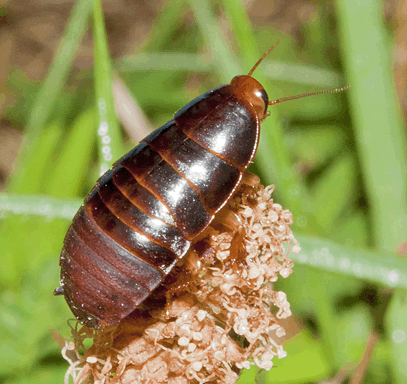 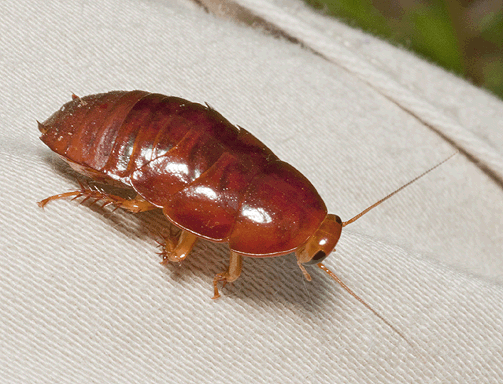
The two individuals above, both nymphs of Pycnoscelus surinamensis, were photographed on April 11, 2012 after being observed crawling on vegetation adjacent to the Smith Preserve pond. On July 10, 2015, they were identified from these photographs by "v belov", Contributing Editor of <BugGuide.net>, sponsored by Iowa State University Department of Entomology.
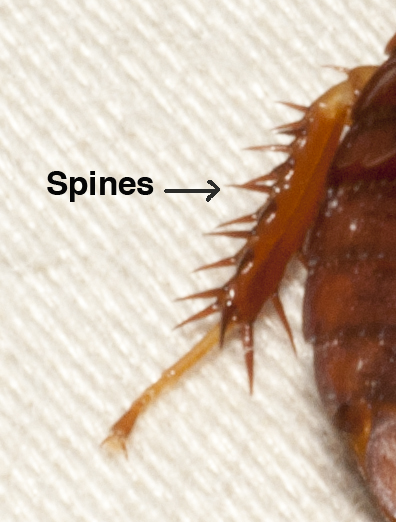 Note the very sharp spines on the ventral and marginal surfaces of the femur as shown in the close-up at right of the second cockroach. Note the very sharp spines on the ventral and marginal surfaces of the femur as shown in the close-up at right of the second cockroach.
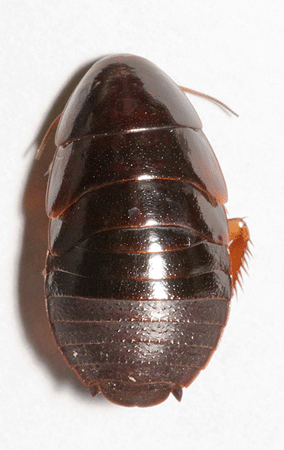
On April 23, 2015, the 15 mm long individual shown in these next two photographs was found on the clothing of the webmaster after she removed exotic vegetation from a scrub area in the northeastern corner of the Smith Preserve.
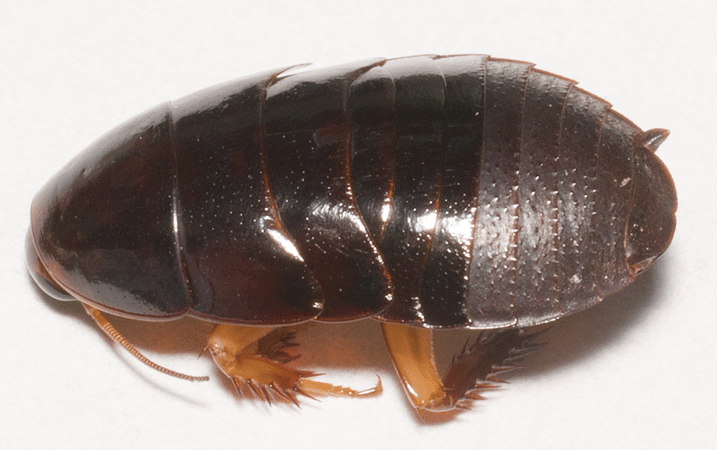
This individual was identified from these photographs by "v belov" on July 9, 2015.
According to <BugGuide.net>, adult Surinam cockroaches are up to 20 mm long. They have olive-green to brown wings covering the abdomen. The pronotum is black or dark brown with a pale edge. Surinam cockroach nymphs are similar to nymphs of Blatta orientalis (Oriental Cockroach), but a Surinam cockroach has a rough posterior abdomen, as can be seen in the last two photographs above.
Surinam cockroaches have been reported in Texas, Louisiana, and Florida. In the United States, there are no males. Reproduction is by parthenogenesis, which means offspring develop from unfertilized eggs.
Return to top
|
Family Blattidae
Periplaneta australasiae .... Australian Cockroach

On January 30, 2025, while removing fallen palm fronds from the middle of the preserve south of the pond, this roach nymph and one like it were disturbed. After doing some research, the webmaster identified the likely species. But the identification needs verification. These images were sent for identification verification to <Bugguide.net>, sponsored by Iowa State University's Department of Plant Pathology, Entomology, and Microbiology. Image one was taken with a cell phone camera by Preserve Volunteer Teri Hoffman. The two images below were taken with a Nikon camera by the webmaster. In all images, the roach was moving very quickly through the layers of leaves.
 
According to the online "Featured Creatures" bulletin produced by UF/IFAS, the Australian cockroach is the most common cockroach species found outdoors in southern Florida. Nymphs are wingless and have light-yellow spots on top of the abdomen. This is a characteristic that can distinguish this species from other Periplaneta species. The identification was confirmed by Alan Jeon, a Contributing Editor of <Bugguide.net>, on February 26, 2025.
Return to top
|
Family Ectobiidae
Cariblatta lutea .... Small Yellow Cockroach
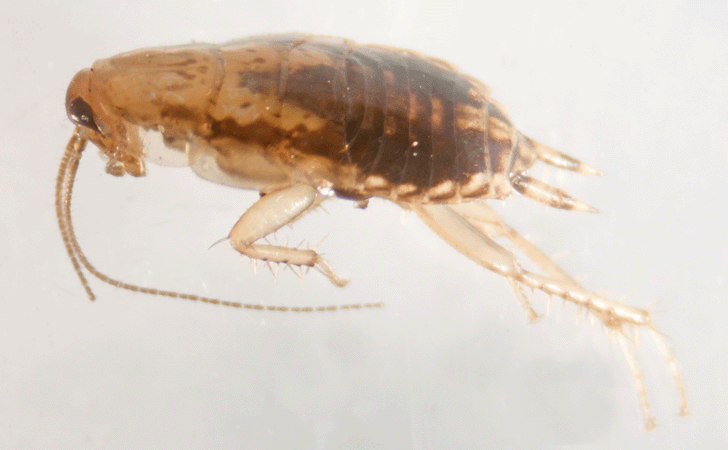 On March 4, 2015, this 6.5 mm long cockroach was living in leaf litter beneath a Quercus geminata (Sand Live Oak) tree in a scrub area in the middle of the Smith Preserve. It was isolated from the leaf litter with a Berlese Funnel. This photograph was created using photomicroscopy. On March 4, 2015, this 6.5 mm long cockroach was living in leaf litter beneath a Quercus geminata (Sand Live Oak) tree in a scrub area in the middle of the Smith Preserve. It was isolated from the leaf litter with a Berlese Funnel. This photograph was created using photomicroscopy.
On March 17, 2015, it was identified from this photograph by Alan Jeon, a Contributing Editor of <BugGuide.net>, sponsored by Iowa State University Department of Entomology.
The genus name "Cariblatta" was named after the Carib people of the Caribbean and "blatta" meaning "an insect that shuns light" (Latin). The species name "lutea" means "yellow" (Latin).
The small yellow cockroach is only ~ 7 mm long as an adult. The range for this species is the coastal plain area of the SE United States and Cuba. There are two subspecies: Cariblatta lutea lutea and Cariblatta lutea minima. Cariblatta lutea lutea is found in leaf, grass, and pine needle litter in southeastern US forests. In Florida it is found in gopher tortoise burrows and disturbed areas. Cariblatta lutea minima is found in hardwood hammocks in southern peninsular Florida and in the Keys, and in scrub, flatwoods, and hammock communities in NE Florida. The subspecies of this individual has not been determined.
Return to top
|
Family Ectobiidae
Cariblatta sp. (either lutea or minima) .... Small Yellow Cockroach or Least Yellow Cockroach
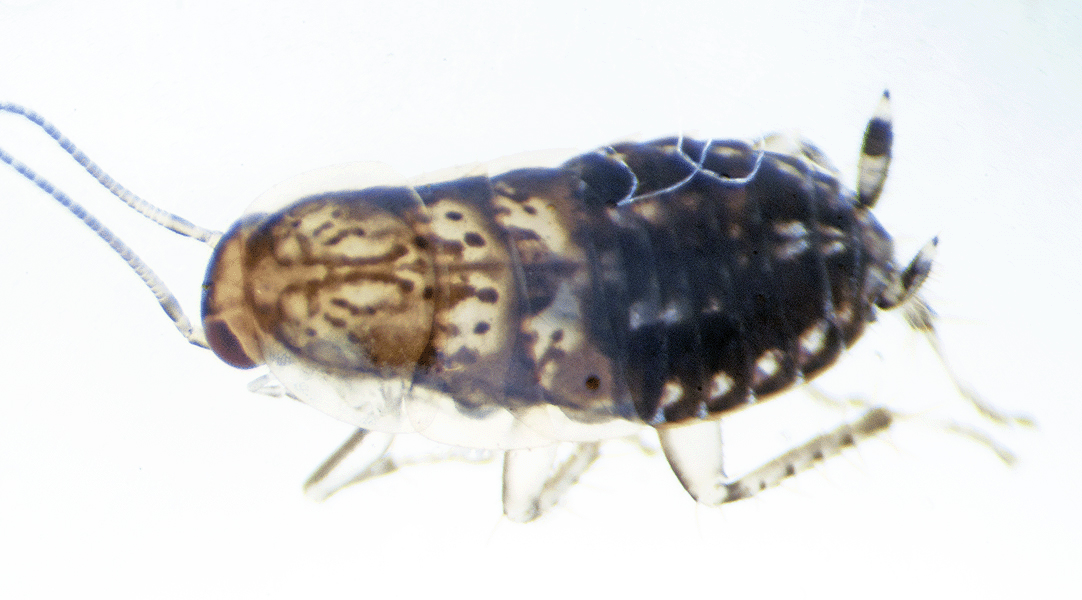
On March 25, 2019, this 5 mm long cockroach nymph was living inside the empty shell of a dead gopher tortoise, located in the scrub, south of Smith Preserve Way. These images were sent for identification to <Bugguide.net>, sponsored by Iowa State University's Department of Entomology.
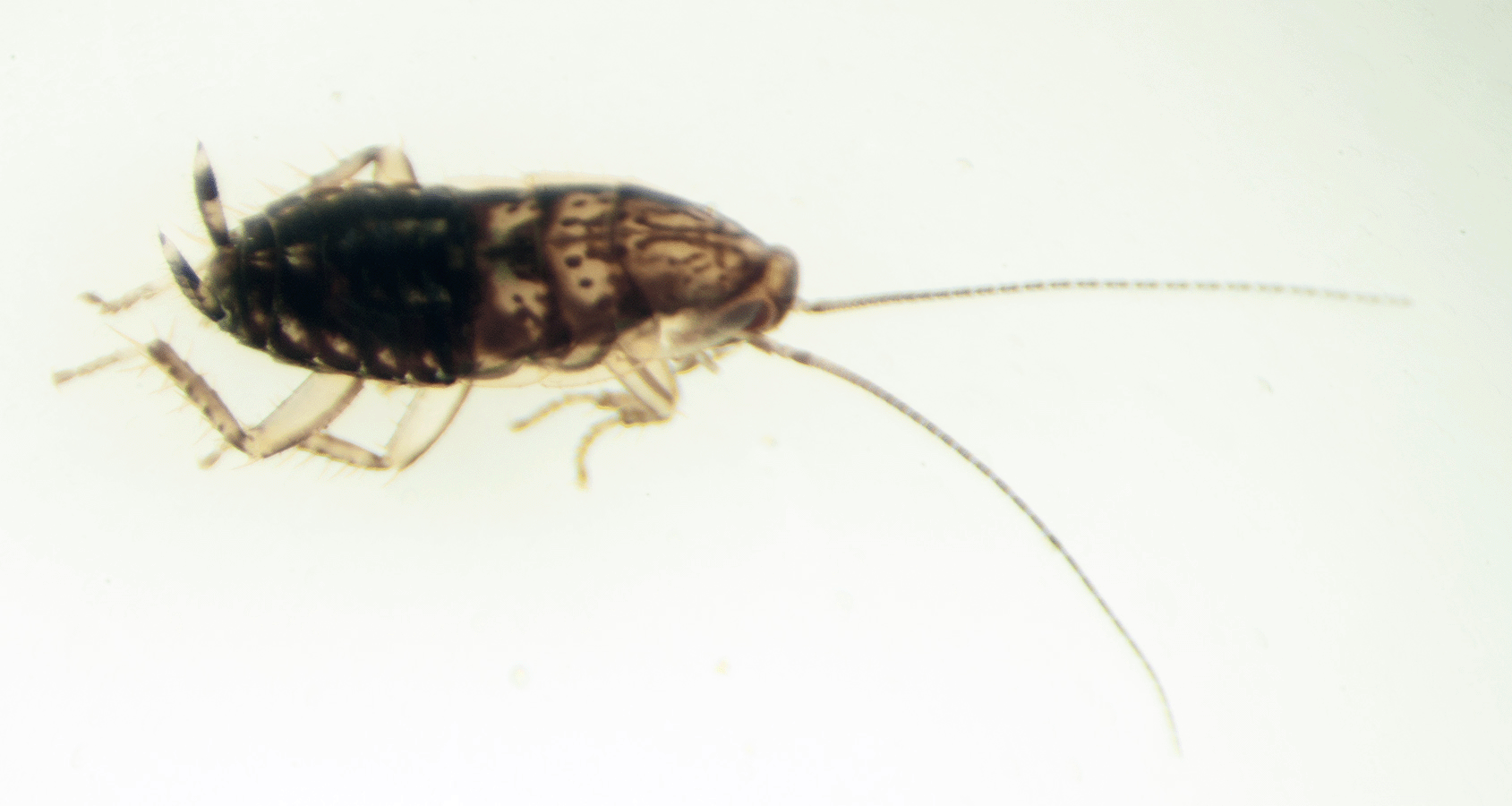
On April 7, 2019, the nymph was identified as a Cariblatta nymph by "Hisserdude", a Contributing Editor of <Bugguide.net>. "Hisserdude" stated, "Cariblatta nymph, can't tell if it's lutea or minima. This individual has coloration that to me both matches minima and lutea. Other than coloration I've no idea how to tell the two apart as nymphs."
As described above, "lutea" is Latin for "yellow". "Minima" means "least."
Return to top
|
Family Ectobiidae
Neoblattella detersa .... Blue Eyed Cockroach
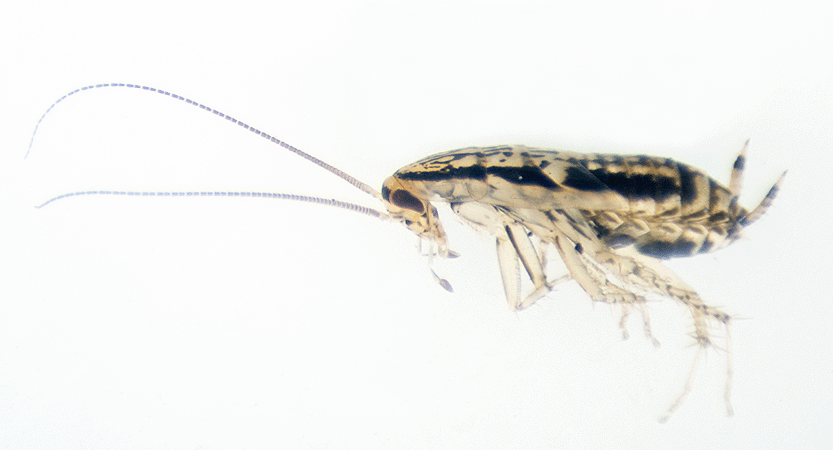
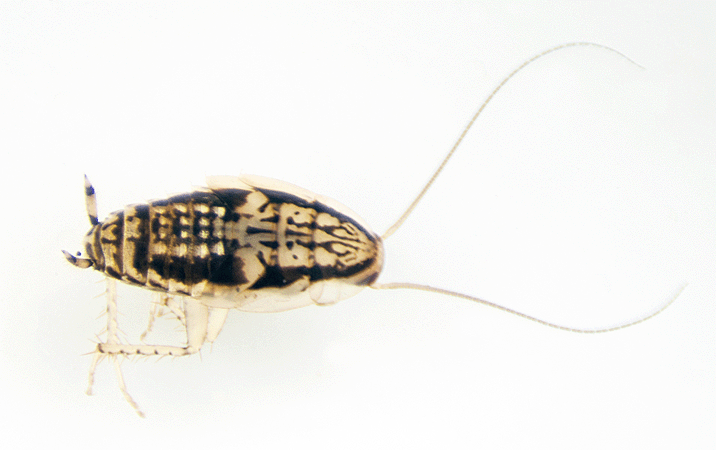
On March 22, 2016, this 6.5 mm long cockroach was living in leaf litter under a Serenoa repens (Saw Palmetto) in the north-central region of the Smith Preserve, north of Smith Preserve Way.
The cockroach was removed from the leaf litter, using a Berlese funnel. Then photographs were created using photomicroscopy and sent for identification to <BugGuide.net>, sponsored by Iowa State University's Department of Entomology.
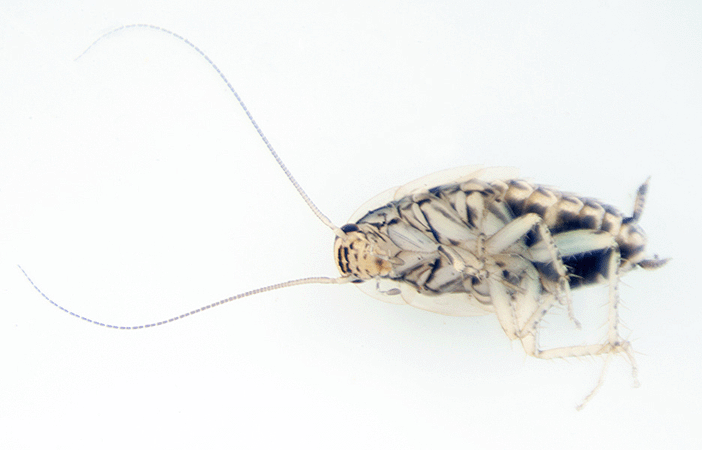 On April 10, 2016, the species was identified by Alan Jeon, a Contributing Editor to <BugGuide.net>. On April 10, 2016, the species was identified by Alan Jeon, a Contributing Editor to <BugGuide.net>.
According to <BugGuide.net>, this species is native to the West Indies (Jamaica and Haiti). The earliest record in North America was in 1984 in Florida.
On November 21, 2023, the 9 mm long cockroach below was extracted from leaf litter that was collected beneath a Coccoloba uvifera (Sea Grape) Tree. The cockroach was separated from the leaf litter with a Berlese funnel.
These images ( Image 1: Dorsal view; Image 2: Ventral view) were created using photomicroscopy, and sent for identification to <Bugguide.net>, sponsored by Iowa State University's Department of Entomology. On February 28, 2024, the family was identified by Tyler Hedlund, a Contributing Editor of <Bugguide.net>.
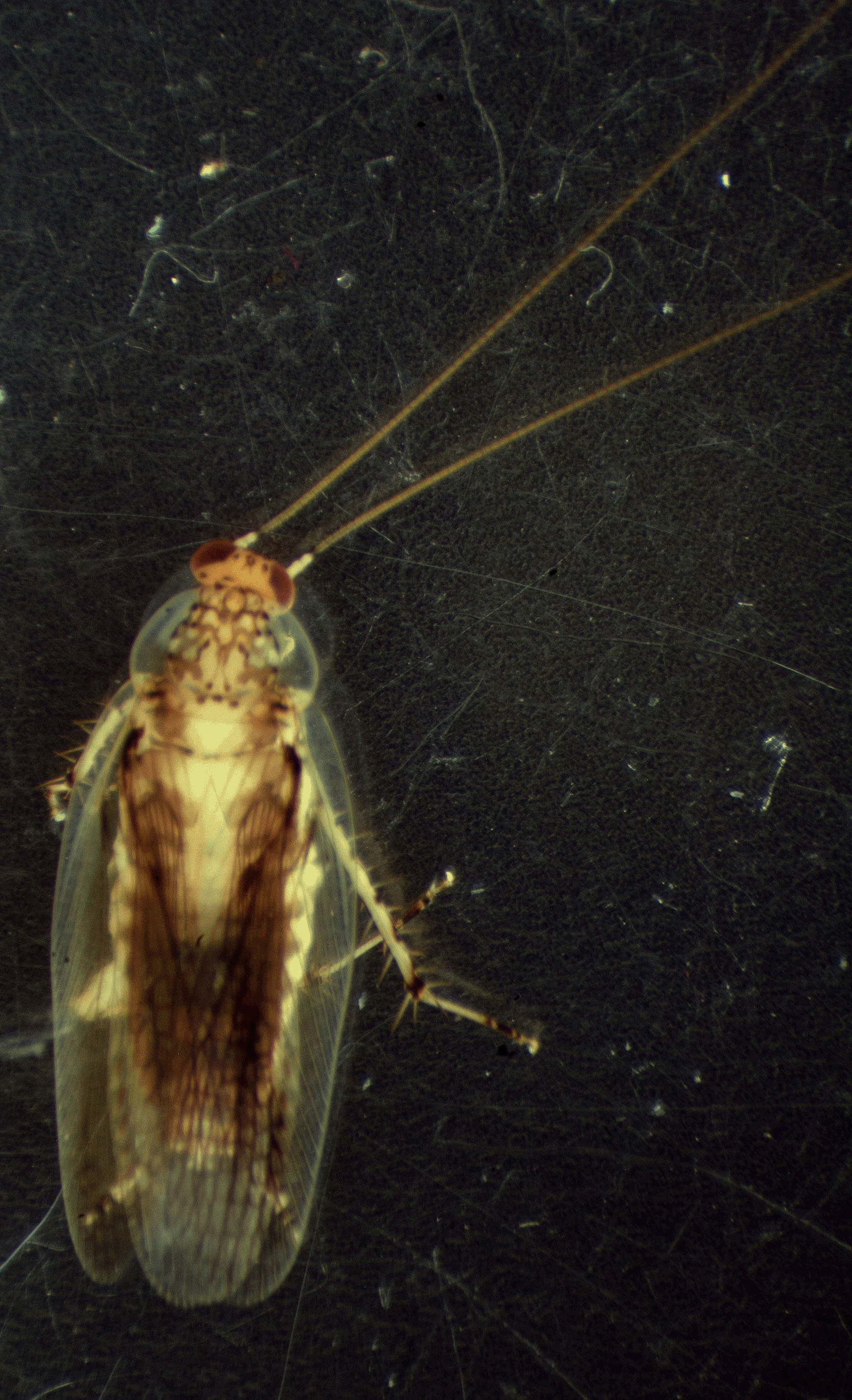 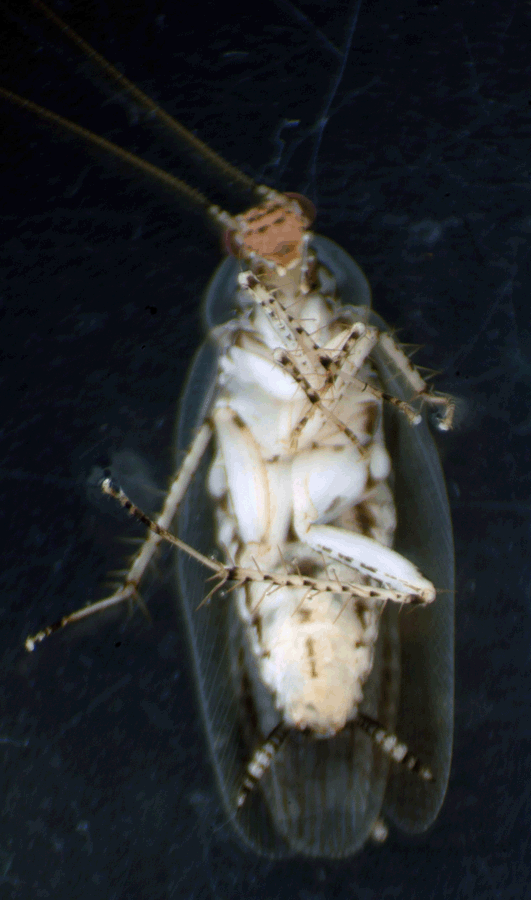
According to <Bugguide.net>, Family Ectobiidae is the largest family in Order Blattodea with 12 genera and 40 species in the United States.
On April 21, 2024, the species was identified by Alan Jeon, a Contributing Editor of <Bugguide.net>.
Return to top
|
Family Ectobiidae
Latiblattella rehni .... Rehn's Cockroach
On February 14, 2023, this 11 mm long cockroach nymph was found living inside a dead bromeliad that was collected in an oak hammock in Smith Preserve. These images were taken by photomicroscopy and sent for identification to <Bugguide.net>, sponsored by Iowa State University's Department of Entomology.
On 24 July, 2024, the species was identified by Alan Jeon, a Contributing Editor of <Bugguide.net>.
 
 
According to <Bugguide.net>, this species' range is Florida, Bahamas, and Cuba.
Return to top
|
Family Rhinotermitidae
Reticulitermes sp. ... Subterranean Termite
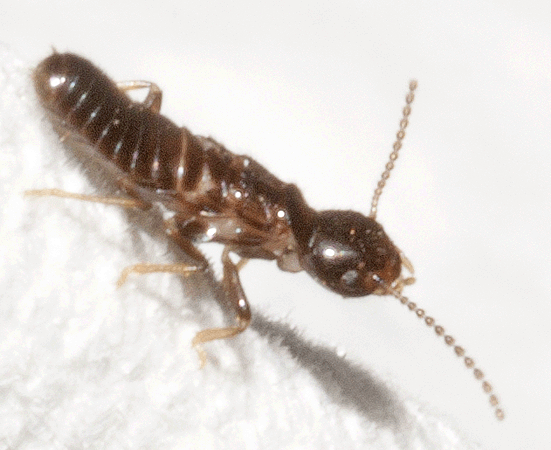
On April 30, 2014, this ~5 mm long insect was on top of the hat of the webmaster as she exited the Christopher B. Smith Preserve.
It appeared to have 16 bead-like segments in each antenna, overlapping abdominal segments like a cockroach, very short cerci, chewing mouth parts, and thoracic segments that resemble those of earwigs.
These images were sent for identification to <BugGuideNet>, sponsored by Iowa State University's Department of Entomology.
On February 3, 2019, Zhao J, a Contributing Editor to <BugGuide.net>, identified the genus.
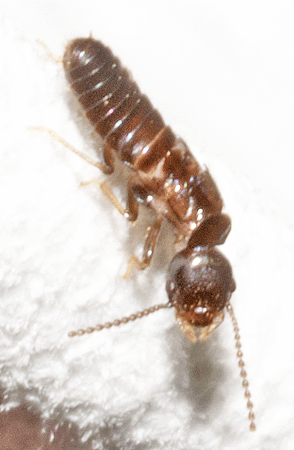 There are three species of the genus that occur in Florida: Reticulitermes flavipes, R. virginicus, and R. hageni. There are three species of the genus that occur in Florida: Reticulitermes flavipes, R. virginicus, and R. hageni.
Reticulitermes flavipes, the eastern subterranean termite, is the most common termite in North America and is one of the most economically important wood destroying insects in the United States. Mature colonies range in size from 20,000 workers to 5 million workers. The primary queen lays 5,000 to 10,000 eggs per day.
Although considered pests by homeowners, they are very important decomposers in habitats like the Smith Preserve.
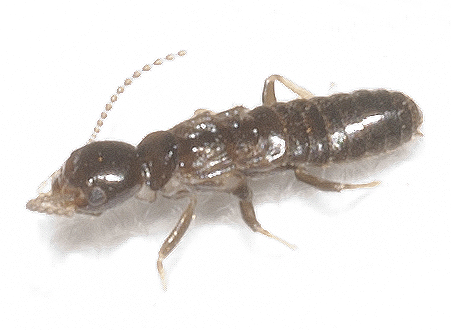
Return to top
|
Family Termitidae
Unknown Species ... Higher Termite
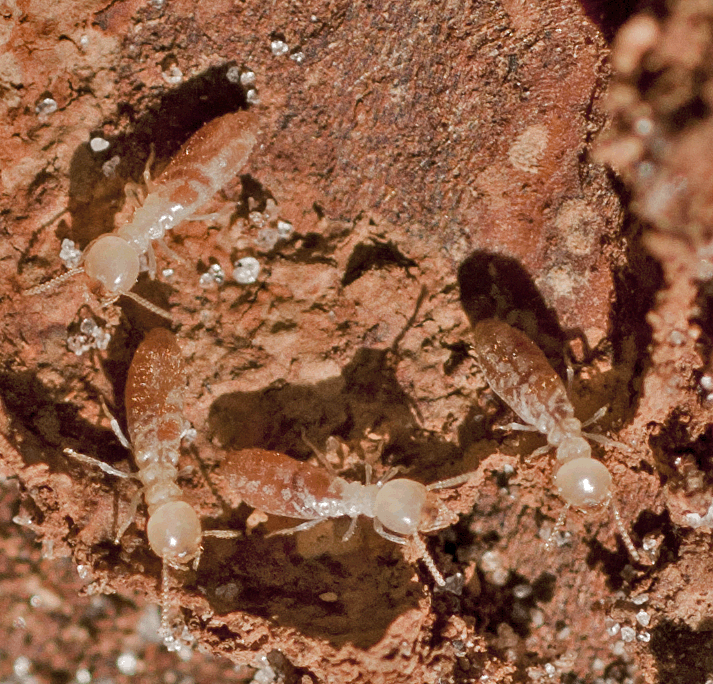 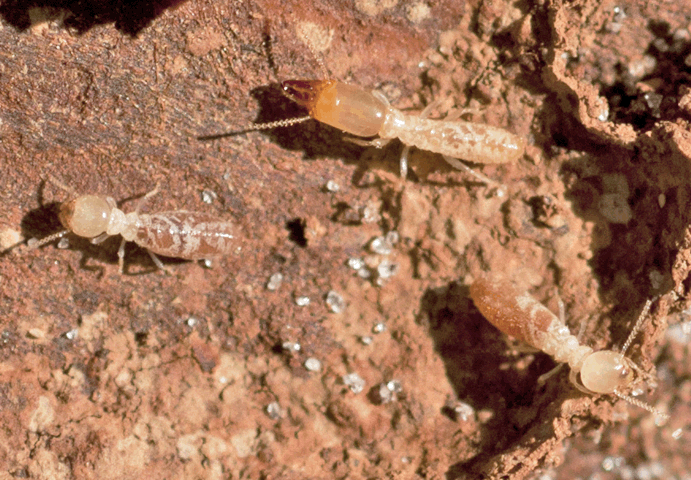
Most drywood termites spend nearly their entire life inside dry wood. Only when alates (adult winged termites) swarm to mate and begin new colonies, do they leave the wood. After locating new dead wood sites, alates shed their wings, mate, and crawl to begin new colonies.
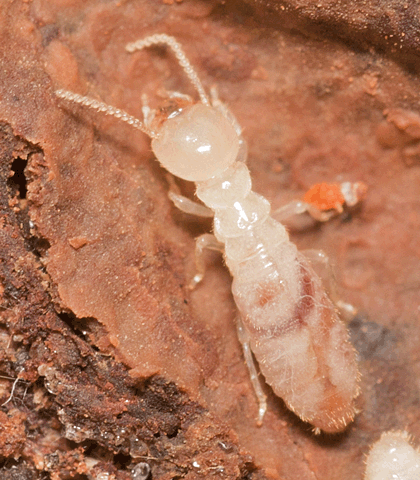 Unlike subterranean termites that live in soil, drywood termites live in wood where they have no access to free water. They must obtain water by metabolizing wood and removing moisture from wood. Since drywood termites live inside their food source, they expel their frass (fecal pellets) out of the wood. To do this they make small holes (1.6 mm in diameter) in the wood. Periodically, they kick frass out the hole. The presence of powdery frass on the surface of wood is a good indicator drywood termites are present. Unlike subterranean termites that live in soil, drywood termites live in wood where they have no access to free water. They must obtain water by metabolizing wood and removing moisture from wood. Since drywood termites live inside their food source, they expel their frass (fecal pellets) out of the wood. To do this they make small holes (1.6 mm in diameter) in the wood. Periodically, they kick frass out the hole. The presence of powdery frass on the surface of wood is a good indicator drywood termites are present.
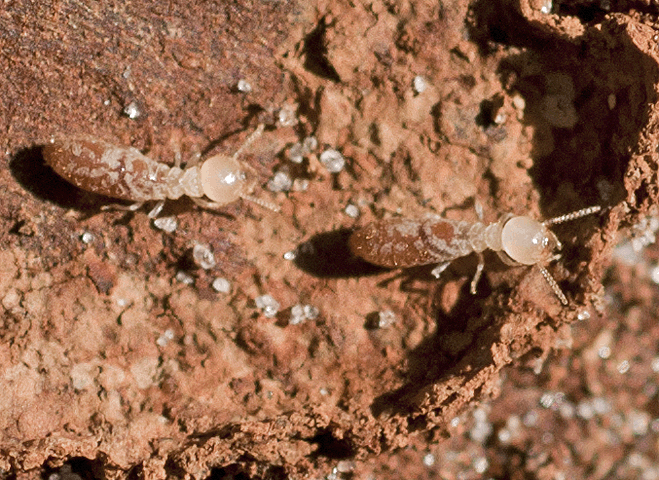 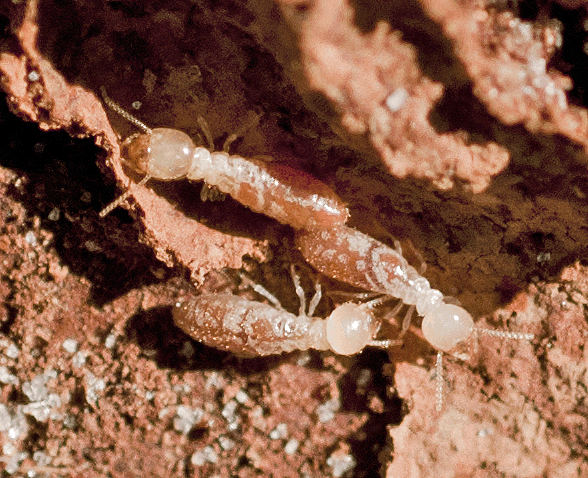 Drywood termites form small colonies. By turning over dead branches in the Smith Preserve scrub, individuals from two colonies were located and photographed. Photographs 1 - 4 show one colony and 5-7 show a second colony. White crystals in the photographs are quartz sand grains. Drywood termites form small colonies. By turning over dead branches in the Smith Preserve scrub, individuals from two colonies were located and photographed. Photographs 1 - 4 show one colony and 5-7 show a second colony. White crystals in the photographs are quartz sand grains.
Most of the individuals are workers. In the second photograph, a larger soldier is shown. It has an elongated head and large pincer-like mandibles. Its function is to defend the colony, especially from predator ants.
Drywood termites alates have hairy wings, the body color is light brown, There are three major veins with many cross veins in the wing, and the body is relatively large compared to subterranean termites.
Drywood termites cause damage to homes, but in the Smith Preserve, they are important nutrient recyclers.
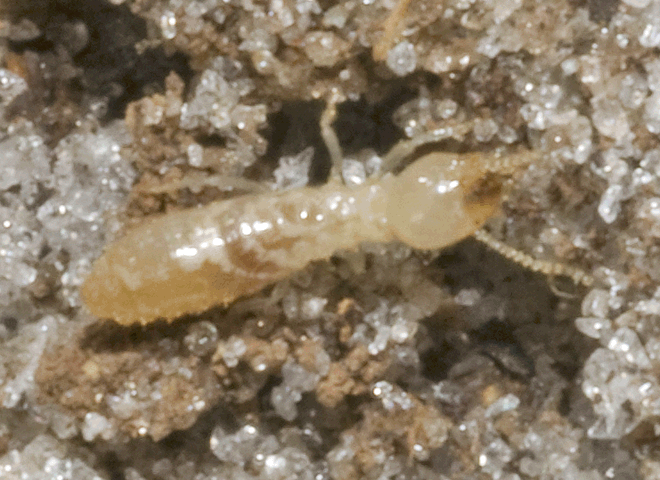 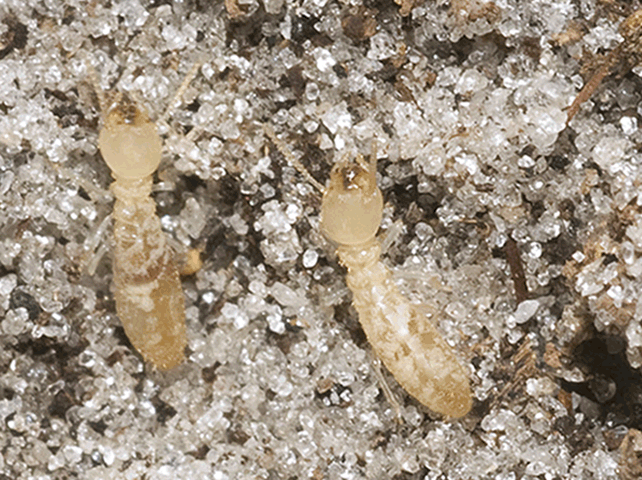 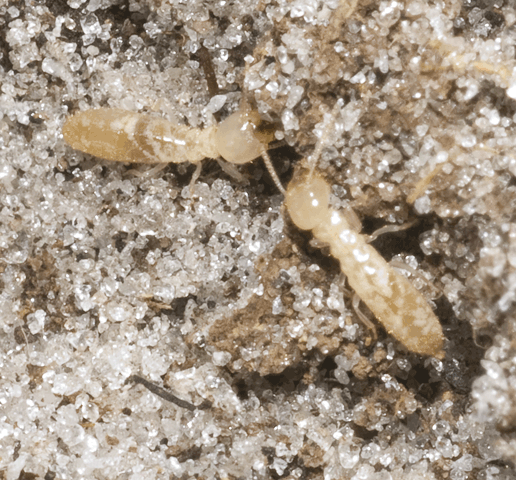
Return to top
|

 B) Termite Cockroaches: There are only 17 species of termites living in Florida. Termites are often confused with ants, but there are several distinctive differences. As shown in these photographs, ants have a narrow division ("waist") between the thorax and abdomen; termites lack this "waist." Winged ants have long, narrow, triangular front wings and much larger hind wings. Winged termites have two pair of wings that are paddle-shaped and almost identical in size. Ants are often seen crawling during the day; termites are rarely seen because they do not venture outside the colony except to reproduce. Termites, like ants, are social insects, but unlike ants, both males and females can be workers or soldiers.
B) Termite Cockroaches: There are only 17 species of termites living in Florida. Termites are often confused with ants, but there are several distinctive differences. As shown in these photographs, ants have a narrow division ("waist") between the thorax and abdomen; termites lack this "waist." Winged ants have long, narrow, triangular front wings and much larger hind wings. Winged termites have two pair of wings that are paddle-shaped and almost identical in size. Ants are often seen crawling during the day; termites are rarely seen because they do not venture outside the colony except to reproduce. Termites, like ants, are social insects, but unlike ants, both males and females can be workers or soldiers. 


 Note the very sharp spines on the ventral and marginal surfaces of the femur as shown in the close-up at right of the second cockroach.
Note the very sharp spines on the ventral and marginal surfaces of the femur as shown in the close-up at right of the second cockroach. 




 On March 4, 2015, this 6.5 mm long cockroach was living in leaf litter beneath a
On March 4, 2015, this 6.5 mm long cockroach was living in leaf litter beneath a 



 On April 10, 2016, the species was identified by Alan Jeon, a Contributing Editor to <BugGuide.net>.
On April 10, 2016, the species was identified by Alan Jeon, a Contributing Editor to <BugGuide.net>. 






 There are three species of the genus that occur in Florida: Reticulitermes flavipes, R. virginicus, and R. hageni.
There are three species of the genus that occur in Florida: Reticulitermes flavipes, R. virginicus, and R. hageni. 


 Unlike subterranean termites that live in soil, drywood termites live in wood where they have no access to free water. They must obtain water by metabolizing wood and removing moisture from wood. Since drywood termites live inside their food source, they expel their frass (fecal pellets) out of the wood. To do this they make small holes (1.6 mm in diameter) in the wood. Periodically, they kick frass out the hole. The presence of powdery frass on the surface of wood is a good indicator drywood termites are present.
Unlike subterranean termites that live in soil, drywood termites live in wood where they have no access to free water. They must obtain water by metabolizing wood and removing moisture from wood. Since drywood termites live inside their food source, they expel their frass (fecal pellets) out of the wood. To do this they make small holes (1.6 mm in diameter) in the wood. Periodically, they kick frass out the hole. The presence of powdery frass on the surface of wood is a good indicator drywood termites are present. 
 Drywood termites form small colonies. By turning over dead branches in the Smith Preserve scrub, individuals from two colonies were located and photographed. Photographs 1 - 4 show one colony and 5-7 show a second colony. White crystals in the photographs are quartz sand grains.
Drywood termites form small colonies. By turning over dead branches in the Smith Preserve scrub, individuals from two colonies were located and photographed. Photographs 1 - 4 show one colony and 5-7 show a second colony. White crystals in the photographs are quartz sand grains.

